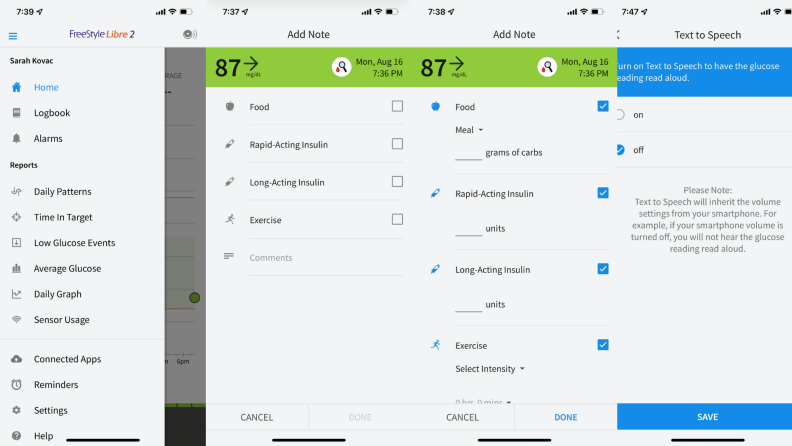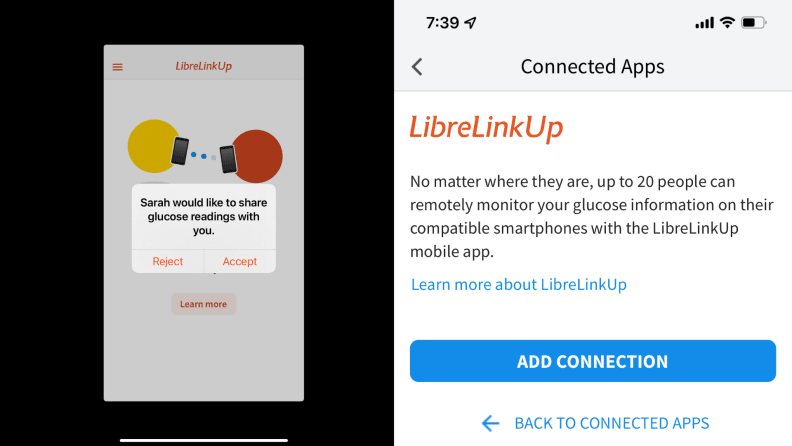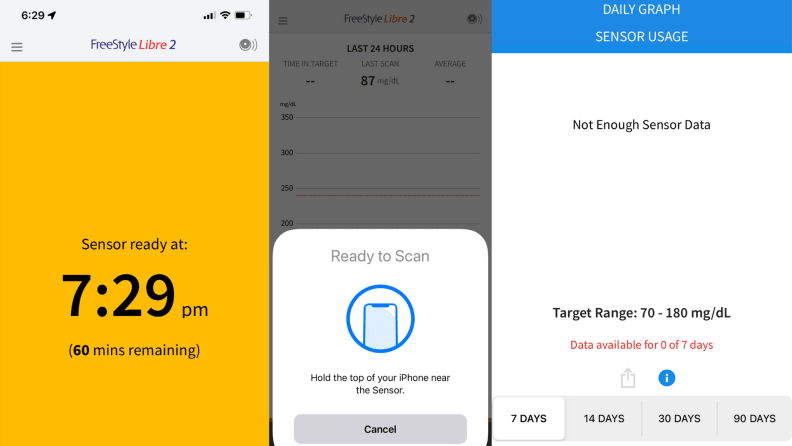This app helps me monitor my daughter's glucose levels
Freestyle's Libre 2 CGM finally has an app available in the U.S.
Products are chosen independently by our editors. Purchases made through our links may earn us a commission.
During a very scary trip to the ER and ICU two months ago, my then-3-year-old daughter was diagnosed with Type 1 diabetes (the autoimmune disease that is not caused by eating too much sugar or candy, thank you very much). Since then, true to form, I have been researching and testing out all the diabetes tech and approaches that I could find to help monitor her glucose levels. We immediately got her on a Dexcom, but I was very curious about the other CGM (continuous glucose monitor) I kept hearing about: the Freestyle Libre 2.
What is a CGM?
A diagnosis of Type 1 diabetes means that one's glucose level needs to be monitored and corrected constantly: at school, while swimming, in the middle of the night. By giving the body appropriate amounts of insulin to process the sugars we consume, we are essentially acting as an external pancreas. Blood sugar that runs too high for too long can cause serious illness and even coma or death. Low blood sugar, on the other hand, can have the similar but immediate effect of seizures along with coma or death. (Turns out being a pancreas a relentless, full-time task, so be sure to tell your pancreas you appreciate all the hard work and, you know, keeping you alive and such.)
CGMs take a bit of the pressure off by notifying us when sugar levels are moving out of a safe range and by allowing us to improve our treatment thanks to pattern analyzation. Dexcom told me that my daughter tends to run high during certain hours of the night, so I've increased her insulin for that timeframe. Most CGMs also alert very loudly when levels are becoming dangerous. Your blood sugar reports can even be shared with caregivers and healthcare providers.
The CGM itself is a sensor that attaches like a sticker to the skin and inserts a tiny probe that measures glucose levels in interstitial fluid: the fluid that surrounds the cells beneath the skin's surface. The sensor collects regular glucose readings, which can be viewed on a PDM (a handheld receiver with a display) or, as with the Dexcom and now Libre 2, an app.
Libre 2 is catching up to Dexcom
Dexcom has long been considered the top CGM, but I wondered if perhaps the Libre might have advanced with their second-generation sensor. We had a coupon for a free Libre 2 sensor and reader (the handheld device that displays the glucose readings collected by the sensor), so I filled the prescription, and, hesitant to use my child as a guinea pig, I put the sensor on myself. After wearing the Freestyle Libre 2 for a few days, I discovered that my random episodes of shakiness and clouded thinking could be explained by my frequent low blood sugars. I was thankful that the Libre helped me discover this, but as most people seemed to agree, the Dexcom system was just more polished and technologically advanced. That is, until now. An iOS app accompanying the Libre 2 became available on iOS only a couple of weeks ago, and after comparing it to the app experience of the Dexcom G6, I have some thoughts.
What I like
The Libre 2 iOS app has a friendly interface

Some of the key features included in Freestyle’s Libre 2 app are centered around personalization through data logging.
The Freestyle Libre 2 app is polished and pleasant to use. It allows logging of meals, exercise, and insulin, and I really like the ability to just create my own custom note. I can put symptoms here if I'm having low blood sugar, so that I can go back and pinpoint exactly when I was feeling the worst.
Competing nicely with the Dexcom app, the Libre 2 app gives trend arrows, pattern analyzation, and the ability to send your chart by email. Most importantly, I receive high, low, and signal loss alarms that alert on both my iPhone and my Apple Watch—a feature that was unavailable (and frequently requested) on previous Libre apps.
Approved loved ones can check my glucose numbers from their devices

It was comforting to know that I could share my daily glucose readings with up to 20 people on their smartphone devices.
Much like Dexcom’s Follow app, the LibreLinkUp app allows anyone with an invitation to check in on your glucose readings whenever they want. The new Libre 2 iOS app also connects to LibreView: an app designed for sharing your chart with your healthcare team.
Freestyle Libre CGMs are easy(ish) on the wallet
The big selling point for the Libre is that it's actually at a small selling point. The cost of the Libre 2 is only a fraction of what we paid for the Dexcom G6. The prices of the sensors are also negligible compared to what you would spend every month on G6 sensors, and they last 14 days instead of Dexcom’s 10-day limit. I love the idea of keeping a little more money in my pocket by using the Libre, but up until now I was concerned that I would miss the Dexcom's app and ability to follow my daughter’s glucose numbers from anywhere, as I can with the G6.
While these numbers will vary with insurance and could be lowered considerably with coupons, without insurance we would have paid $1,553 per 90 days of Dexcom supplies, and a one-time charge of $456 for the optional handheld receiver. For that same timeframe with Libre 2 sans insurance, the cost would have been $395 plus $85 for the optional receiver.
The apps for both the Dexcom G6 and the Libre 2 are free, however the Libre 2 has only released an iOS app in the United States. Those who want to follow their Libre’s data on an Android must either buy a Bluetooth add-on like the NightRider BluCon or patch the CGM using one of various methods found online. It should be noted, however, that the BluCon only works with the first-gen Libre (called the Libre 1 or Libre 14-Day).
While the wearer's app (the one that scans the sensor and sends the readings to the cloud) is only available on iOS at the time of this writing, the apps others can use to follow along with your readings are available for both Apple and Android phones. So as long as the sensor-wearer has an iOS device, anyone with an Apple or Android can see the sensor readings.
What I don't like
The Freestyle receiver no longer works
One of my very favorite things about the Libre 2 receiver is that it has an integrated glucose meter. Meaning, if I am unsure about the Libre’s stated glucose level, I can just insert a test strip into the bottom of the receiver and test my blood right there. It automatically logs the result along with all of its automatic readings.
Logging a manual reading does not calibrate the sensor, which seems like a lost opportunity, but I still really liked having that feature built into the receiver itself—one less thing to carry. It made me sad, therefore, when I was no longer able to use the receiver once a sensor had been initiated with the phone app. In contrast, the Dexcom G6 can transmit to both a phone and its receiver.
Readings are not automatic

The lack of automatic chart updates through the Libre 2 app could be a danger to children whose caregivers are monitoring their levels remotely.
To use the Libre 2 monitor with its standalone receiver, how it’s always been used before now, you hold the receiver next to the sensor on your arm and your current reading is displayed on the screen. This is done through near field communication, or NFC, a protocol that passes information between two devices that are touching, much like the way some credit cards can be used just by tapping the card terminal. When the Libre receiver touches the sensor, you’ll also see the chart update with the trend line since your last scan. The phone app works the exact same way. The user has to take physical action for the app to update with new readings and send those to those following along with the LibreLinkUp app.
For an adult who is responsible enough to frequently check their blood sugar, this would be no problem. For kids heading off to school, however, it’s less than ideal. You’d have to trust the teachers to check your child’s glucose frequently so that you can stay updated. The upside is that you'd be notified the moment your kid's sensor is scanned, so you know exactly when and how often the teacher or nurse is checking.
Another option would be to downgrade to the Libre 1 (also called the "14-Day") and buy a compatible Bluetooth transmitter. These one-time purchases are little sensors that sit on top of or next to the Libre, automatically scanning for readings and sending that data to your phone. This eliminates the need for physical scans and makes the Libre operate almost identically to the Dexcom, even down to the alarms, which come from the transmitter's app.
The Nightrider BluCon mentioned above is the transmitter we tried, but the MiaoMiao is another popular choice.
Is the Libre 2 iOS app worth it?

While this useful app serves its purpose in aiding those like my child with diabetes, I wouldn't exactly consider it to be innovative compared to the Dexcom.
If the wearer has an iOS device and doesn’t mind scanning their sensor every so often, the Libre 2 is a great option now that it has an app. Adding on the BluCon, however, makes the Libre 2 a no-brainer, even for children and Android users, as it works with both operating systems and automatically sends readings to a phone via Bluetooth every 5 minutes, just like the pricier Dexcom. I felt completely comfortable in the knowledge that I had the most up-to-date data even away from my daughter while she was wearing the Libre 1/BluCon combo.
BluCon has been around for a bit, though, and it uses its own app. So the Libre 2’s new app doesn’t bring anything groundbreaking to the table, but it’s certainly technology that should be available on a modern CGM.
